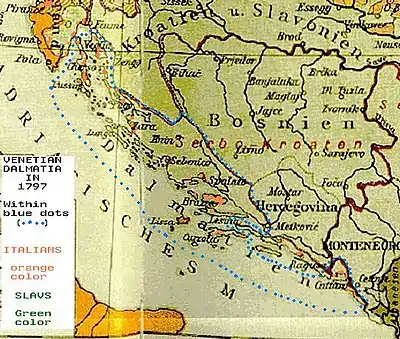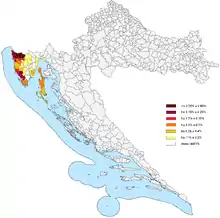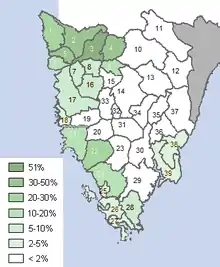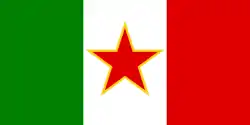Italians of Croatia
Italians of Croatia are an autochthonous historical national minority recognized by the Constitution of Croatia. As such, they elect a special representative to the Croatian Parliament.[1] There is Italian Union of Croatia and Slovenia, in Croat Talijanska Unija, in Slovene Italijanska Unija, which is Croat-Slovene organization with main site in Fiume-Rijeka and secondary site in Capodistria-Koper of Slovenia.
There are two main groups of Italians in Croatia, based on geographical origin:
According to the 2011 Croatian census, Italians of Croatia number 17,807, or 0.42% of the total Croatian population. They mostly reside in the county of Istria. [2]
As of 2009, the Italian language is officially used in twenty cities and municipalities and ten other settlements in Croatia, according to the European Charter for Regional or Minority Languages.[3]
History
The Italians of Croatia are the descendants of the Dalmatians and Istrians (neo-Latin peoples originating in the Middle Ages from the Romanized Illyrians) and of the Venetians transplanted to the overseas Adriatic territories of the Serenissima. In the last two centuries some Italians have also moved from Italian peninsula, as in the case of Apulian emigrants in Ragusa and Trentino in Pozega.
In Istria there are still large communities of Italians (about 7% of the population), while in Dalmatia there are only small Italian groups of modest numbers, the last evidence of a presence that descends directly from the Romance-speaking populations that survived the Slavic invasions .
The Italian community at the beginning of the twentieth century was still very substantial, being a majority in the most important Istrian coastal centers and in some centers in Kvarner and Dalmatia. According to the Austrian censuses, which collected the declarations relating to the language of use in 1880, 1890, 1900 and 1910, in the Istrian geographical region - which differed from the Marquisate of Istria in that the main Kvarner islands were added to the latter - Italian speakers spoke from 37.59% (1910) to 41.66% (1880) of the total population, concentrated in the western coastal areas where they also reached 90%. In Dalmatia, however, they were quite numerous only in the main cities, such as Zadar (the only Dalmatian mainland where they were majority), Split, Trogir, Sibenik, Ragusa and Kotor, and in some islands such as Krk, Cres, Lošinj, Rab, Lissa and Brazza. In these they were majorities in the centers of Cres, Mali Lošinj, Veli Lošinj and, according to the 1880 census, in the cities of Krk and Rab.
In Rijeka the Italians were the relative majority in the municipality (48.61% in 1910), and in addition to the large Croatian community (25.95% in the same year), there was also a fair Hungarian minority (13.03%).

With the awakening of national consciences (second half of the nineteenth century), the struggle between Italians and Slavs for dominion over Istria and Dalmatia began. The Italian community in Dalmatia was almost canceled by this clash between opposing nationalisms, which saw several stages:
- Between 1848 and 1918 the Austro-Hungarian Empire - particularly after the loss of Veneto following the Third War of Independence (1866) - favored the establishment of the Slavic ethnic group to counter the irredentism (true or presumed) of the Italian population. During the meeting of the council of ministers on November 12, 1866, Emperor Franz Joseph fully outlined a wide-ranging plan in this regard:
His Majesty expressed the precise order that decisive action be taken against the influence of the Italian elements still present in some regions of the Crown and, appropriately occupying the positions of public, judicial, master employees as well as with the influence of the press, work in Alto Adige, in Dalmatia and on the Littoral for the Germanization and the Slavicization of these territories according to the circumstances, with energy and without any regard. His majesty reminds the central offices of the strong duty to proceed in this way to what has been established.
The policy of collaboration with the local Serbs, inaugurated by the Tsaratino Ghiglianovich and the Raguseo Giovanni Avoscani, then allowed the Italians to conquer the municipal administration of Ragusa in 1899. In 1909 the Italian language was prohibited, however, in all public buildings and Italians they were ousted from the municipal administrations.[6] These interferences, together with other aiding actions to the Slavic ethnic group considered by the empire more faithful to the crown, exacerbated the situation by feeding the most extremist and revolutionary currents.
- After the First World War, with the annexation of most of Dalmatia to Yugoslavia, the exodus of some thousands of Italian Dalmatians to Zadar and Italy occurred. Italian citizenship was granted to the few remaining, concentrated mainly in Split and Ragusa following the Treaty of Rapallo (1920). Zara, whose population was mostly Italian (66.29% in the city of Zara, according to the census of 1910), was annexed to the Kingdom of Italy together with Istria in 1920. Fiume was annexed to Italy in 1924.
- For a short period during the invasion of Yugoslavia (1941-1943) the Governatorate of Dalmatia was inserted in the Kingdom of Italy, with three provinces: Zadar, Split and Kotor.
- After the Second World War, all Dalmatia and almost all of Istria were annexed to Yugoslavia. Most Italians took the road of exodus, which ran from 1943 until the late 1950s. The Italians who remained in Yugoslavia, gathered in the Italian Union, were recognized as a national minority, with their own flag.
Italian community in Croatia today

The Italians in Croatia represent a residual minority of those indigenous Italian populations that inhabited for centuries and in large numbers, the coasts of Istria and the main cities of this and the coasts and islands of Dalmatia, which were territories of the Republic of Venice. After the conquest of Napoleon and his donation of the territories that belonged to the ancient Venetian Republic to the Habsburg Empire, these Italian populations had to undergo Austro-Hungarian power. After the First World War and the D'Annunzio enterprise of Fiume many of the Istrian and Dalmatian territories passed to the Kingdom of Italy, strengthening the Italian majority in Istria and Dalmatia. These populations were of Italian language and culture, speaking Venetian dialect and lived as a majority of the population in Istria and Dalmatia until the Second World War. After the Nazi-Fascist occupation of the Balkans, Slavic-speaking populations following the partisan commander Tito started a persecution of the Italian populations that had inhabited Istria and Dalmatia for several centuries. For fear of ethnic retaliation by the Slavic populations, the majority of Italians from Istria and Dalmatia poured into a real exodus towards Trieste and Triveneto. Subsequently many of them were transferred by the authorities of the Italian Republic to southern Lazio and Sardinia where they formed numerous local communities. 34,345 Italians live in Croatia since the census conducted in Croatia on 29 June 2014, through self-certification (Italian Union data): according to official data at the 2001 census, 20,521 declared themselves to be native Italian speakers[8] and 19,636 declared to be of Italian ethnicity[9]). The Italian Croats create 51 local Italian National Communities and are organized in the Italian Union (UI).
According to Maurizio Tremul, president of the executive council of the UI, the census data in the part in which it is asked to declare the ethnicity are a bit distorted due to a "reverential fear" towards the censors who do not use Italian nor bilingual forms. The Croatian census in 2011 used a new methodology for the first time so that anyone who was not a resident of the territory or was not found at home was not surveyed.[10]
The Italians are mainly settled in the area of Istria, the islands of Kvarner and Rijeka. In coastal Dalmatia there are only 500 left, almost all of them in Zadar and Split.
They are recognized by some municipal statutes as an indigenous population: in part of Istria (both in the Croatian Istrian region, in the four coastal municipalities of Slovenia), in parts of the region of Rijeka (Primorje-Gorski Kotar County) and in the Lošinj archipelago, while in the rest of Kvarner and in Dalmatia no particular status is granted to them.
In the city of Rijeka, where the largest Italian-language newspaper in Croatia is located, as well as some schools in Italian, officially there are about 2300 Italians, although the local Italian community in Rijeka has approximately 7500 members.
The indigenous Venetian populations (north-western Istria and Dalmatia) and the Istriot-speaking peoples of the south-western Istrian coast are included in this Italian ethnic group.
During the 19th century, a considerable number of Italian craftsmen moved to live in Zagreb and Slavonia (Požega), where many of their descendants still live. A local Community of Italians was formed in Zagreb, which mainly brings together among its members recent immigrants from Italy, as well as a fair number of Italian-speaking Istrians who have moved to the capital.
In Croatian Istria - between the towns of Valdarsa and Seiane - there is the small ethnic community of the Istroromeni or Cicci, a population originally from Romania whose language, of Latin and Romanian-like, is in danger of extinction in favor of the Croatian . During Fascism these Istrorumeni were considered ethnically Italian because of their mixing during the Middle Ages with the descendants of the Ladin populations of Roman Istria, and they were guaranteed elementary teaching in their native language.[11]
According to the 2001 census, the municipalities of Croatia with the highest percentage of Italian-speaking inhabitants were all in Istria (mainly in the areas of the former zone B of the Free Territory of Trieste):
- Grisignana: 66.11%
- Verteneglio: 41.29%
- Buie: 39.66%
- Portole: 32.11%
- Valle d'Istria: 22.54%
- Umago: 20.70%
- Dignano: 20.03%
Grisignana (in Croatian "Grožnjan") is the only town with an absolute Italian-speaking majority in Croatia: over 2/3 of citizens still speak Italian and in the 2001 census over 53% declared themselves "native Italian" , while Gallesano (in Croatian "Galižana") fraction of Dignano (in Croatian "Vodnjan") with 60% of the Italian population is the inhabited center of Istria with the highest percentage of Italians.
Croatisation

The Italian-Croatians have experienced a process of croatization over the past two centuries. This process was "overwhelming" especially in Dalmatia, where in 1865 the Austrian censuses recorded 55,020 Italian speakers, equal to 12.5% of the total, reduced in 1910 to 18,028 (2.8%).[12] In 2001 about 500 were counted, concentrated mainly in Zadar.
The Italian-Croatians practically disappeared from the islands of central and southern Dalmatia during the rule of Titus, while at the time of the Risorgimento the Italians were still numerous in Lissa and other Dalmatian islands.
Even in Dalmatian cities there was a similar decrease: in the city of Split in 1910 there were over 2,082 Italians (9.75% of the population), while today only a hundred remain around the local Community of Italians (Comunità degli Italiani)
The last blow to the Italian presence in Dalmatia and in some areas of Kvarner and Istria took place in October 1953, when the Italian schools in Communist Yugoslavia were closed and the pupils moved imperiously to the Croatian schools.
In Lagosta (in Croatian Lastovo), which belonged to the Kingdom of Italy from 1918 to 1947, there are still some Italian-Croatian families not fully Croatianized today.
Lagosta and Pelagosa (Lastovo and Palagruža)
The island of Lagosta belonged to Italy from 1920 until the end of the Second World War. While up to 1910 the presence of Italian speakers on the island was laughable (8 in the territory of the municipality out of a total of 1,417 inhabitants), in the 1920s and 1930s several families of Italian Dalmatians moved from the areas of Dalmatia passed to the Yugoslavia. In the 1930s, about half of the inhabitants were Italian-speaking, but emigrated almost entirely after the end of the Second World War.
Some Venetian or Italian-speaking families (although very Croatian) are still present on the island of Lesina, where the creation of an Italian Union headquarters - named after the Lesignano writer Giovanni Francesco Biondi - for all Italian-Croatians of Dalmatia has been promoted Southern.
Pelagosa (and its small archipelago) was populated together with the nearby Tremiti islands by Ferdinando II of the Kingdom of the Two Sicilies in 1843 with fishermen from Ischia, who continued to speak the dialect of origin there. The attempt failed and the few fishermen emigrated in the late nineteenth century. During Fascism, the Italian authorities transplanted some fishermen from Tremiti, who left the island when it officially passed to Yugoslavia in 1947. The Pelagosa archipelago is uninhabited.
Education and Italian language
In many municipalities in the Istrian region (Croatia) there are bilingual statutes, and the Italian language is considered to be a co-official language.
There are some Italian schools in Istria, especially in the territories of the former zone B: elementary schools in Buje, Umag, Novigrad, Porec, Pula and Rovinj; middle schools in Pula and Rovinj.
In the city of Rijeka, the Italian school has kindergartens, elementary, middle and high schools. The proposal to raise Italian to a co-official language, as in the Istrian Region, has been under discussion for years.
By recognizing and respecting its cultural and historical legacy, the City of Rijeka ensures the use of its language and writing to the Italian indigenous national minority in public affairs relating to the sphere of self-government of the City of Rijeka. The City of Fiume, within the scope of its possibilities, ensures and supports the educational and cultural activity of the members of the indigenous Italian minority and its institutions.[13]
In Zadar, the local Community of Italians has requested the creation of an Italian asylum since 2009. After considerable government opposition,[14][15] with the imposition of a national filter that imposed the obligation to possess Italian citizenship for registration, in the end in 2013 it was opened hosting the first 25 children.[16] Since 2017, a Croatian primary school has been offering the study of the Italian language as a foreign language. Italian courses have also been activated in a secondary school and at the faculty of literature and philosophy.[17] An Italian kindergarten was also opened in Mali Lošinj in 2010.
Flag
.svg.png.webp) | |
| Proportion | 1:2[18] |
|---|---|
| Design | A vertical tricolor of green, white and red |

The flag of Italians of Croatia is the ethnic flag of Italians of Croatia. The flag was introduced on the basis of decisions of Unione Italiana which acts on the territory of Slovenia and Croatia as the highest body of minority self-government of the Italian minority in Croatia and Slovenia.
References
- "Pravo pripadnika nacionalnih manjina u Republici Hrvatskoj na zastupljenost u Hrvatskom saboru". Zakon o izborima zastupnika u Hrvatski sabor (in Croatian). Croatian Parliament. Retrieved 2011-12-29.
- 2011 Croatian census
- "Europska povelja o regionalnim ili manjinskim jezicima" (in Croatian). Ministry of Justice (Croatia). 2011-04-12. Archived from the original on December 27, 2013. Retrieved 2012-02-08.
- Die Protokolle des Österreichischen Ministerrates 1848/1867. V Abteilung: Die Ministerien Rainer und Mensdorff. VI Abteilung: Das Ministerium Belcredi, Wien, Österreichischer Bundesverlag für Unterricht, Wissenschaft und Kunst 1971
- Jürgen Baurmann; Hartmut Gunther; Ulrich Knoop (1993). Homo scribens : Perspektiven der Schriftlichkeitsforschung (in German). Tübingen. p. 279. ISBN 3484311347.
- Dizionario Enciclopedico Italiano (Vol. III, p. 730), Roma, Ed. Istituto dell'Enciclopedia Italiana, founded by Giovanni Treccani, 1970
- Croatian Bureau of Statistics - Census of Population, Householdes and Dwellings, 2011
- 2001 Census
- 2001 Census
- "Il passaporto sotto al cuscino". Salto.bz. 2018-01-25. Retrieved 2020-05-17.
- Another ethnic group originally of Romance language is that of the Morlacchi, a historical population deriving - according to the majority theories - from the ancient Latinized populations of the Dalmatian hinterland, subsequently Slavic.
- Tutti i dati in Š.Peričić, O broju Talijana/talijanaša u Dalmaciji XIX. stoljeća, in Radovi Zavoda za povijesne znanosti HAZU u Zadru, n. 45/2003, p. 342
- Government use of the Italian language in Rijeka
- Reazioni scandalizzate per il rifiuto governativo croato ad autorizzare un asilo italiano a Zara
- Zara: ok all'apertura dell'asilo italiano
- Aperto “Pinocchio”, primo asilo italiano nella città di Zara
- "L'italiano con modello C a breve in una scuola di Zara". Archived from the original on 10 April 2018. Retrieved 9 April 2018.
- The FAME: Hrvatska - nacionalne manjine
Literature
- Monzali, Luciano (2016). "A Difficult and Silent Return: Italian Exiles from Dalmatia and Yugoslav Zadar/Zara after the Second World War". Balcanica. 47 (47): 317–328. doi:10.2298/BALC1647317M.